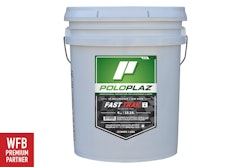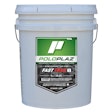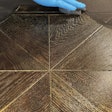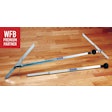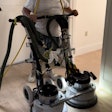Between rollers, T-bars, lambswool applicators, brushes and the occasional rag, there are so many ways to get finish on your floor that figuring out what to use can be confusing. Here is a simple way to break down the proper applicators for the four most commonly used finish types. As always, defer to the finish manufacturer's instructions, be sure to use the right respirator, and have your MSDS on hand.
Oil-Modified Polyurethane
The trick to oil-modified polyurethane (frequently called "poly") is generally "more is better;" you don't want the finish to puddle, but you want to get as much on the floor as possible and spread it as fast as possible to get the smoothest appearance on the floor. There are oldschool methods and newer methods to accomplishing this. Many old timers in the industry like to use a China bristle brush. These brushes are made of hog's hair, which are actually hollow inside. The brush sucks up finish, which gets released as you glide the finish onto the floor. Many people claim this is the best method for applying finish, since you're so much closer to the floor and you can see missed spots ("holidays") or blemishes in the finish and correct the problem before it dries. China bristle brushes can be cleaned off with just mineral spirits.
RELATED: Finish Flaws: Avoid Common Wood Floor Finish Failures
Another old-school applicator for oil-modified is the lambswool applicator on the block, which is made from either 100 percent lambswool or synthetic lambswool. Again, like the China bristle brush, this applicator holds a lot of finish. Natural lambswool tends to hold more finish than synthetic, but the synthetic definitely still does the job and is a little cheaper, which is why I think it's seen more in the industry. With the lambswool on the block, unlike the brush, you're standing upright and away from the floor, which means you have to be a little more careful as you're applying to make sure you're not making any mistakes.
There are some other caveats to the lambswool. Recently purchased natural lambswool applicators tend to shed fibers that get stuck in the finish, so before using one, simply comb out the applicator with a pocket comb or wrap it up in blue tape and remove the tape. Other guys might wash it without detergent and let it dry. This is used for the first coat of finish. For subsequent finishes, use lambswool applicators you've already used on at least 500 to 1,000 feet of finish; this gives a much smoother application. Lambswool applicators need to be stored in either mineral spirits or polyurethane.
Some of the newer applicators are making finish application even easier. Just like your transition from riding a tricycle to a bike with training wheels to a standard bike, you work up from old-school applicators to new-school. A T-bar applicator, especially with tapered ends, is great for applying any finish. It allows you to get around doorjambs, and it puts a lot of finish down faster than a lambswool applicator. Some companies also manufacture a lambswool sleeve that can be slipped onto a T-bar. This speeds up application, and it also holds a lot of finish. Another option is rolling finish on with a ¼-inch or 3/8 -inch roller. This gets the finish down fast and agitates the floor very little (more agitation to the finish makes it look worse).
Waterborne Urethane
All the applicators for water-based urethane are synthetic. When applying this type of finish, you definitely don't want to use a China bristle brush or lambswool applicator because the two hold a lot of finish and, unlike oil, you don't want all that on the floor; water-based is designed to go down thinner. Synthetic applicators just spread finish; they don't hold any finish in them. Many of the same synthetic applicators, except lambswool, can be used with water-based: a synthetic pad on a block, a T-bar with a synthetic sleeve or a roller. The cut-in pad you use for the edges of the flooring should also be synthetic.
Moisture-Cure Urethane
Many guys have different systems for applying moisture cure finish, which is mostly used on the East Coast. With this finish, contractors tend to use a brush—either a 6-inch China bristle or 12-inch brush—as opposed to the T-bar. It's a fast-applying finish, so using a roller also works.
Conversion Varnish
One of the most efficient ways to apply conversion varnish, which is also called "acid-cure" or "Swedish" finish, is with a brush. Contractors can choose between a 6-inch China bristle or a 12-inch brush, but the main point is to get down so you can see the finish being applied. Conversion varnish has a tendency to separate and leave missed spots, so if you're down on your knees applying with a brush, you can see anything that's missed. As with many finishes, conversion varnish can also be applied with a roller. Here, you have to follow the manufacturer's recommendations for which sleeve to use on the roller, and you have to be certain you're applying enough finish. Application of this finish is easy, but typically the cleanup is more involved, requiring a lacquer thinner.
Using the proper applicators for each finish and getting the correct spread rate is essential to making that finish look great. Using the best applicator for that type of finish, and following the manufacturer's instructions, will help you "get 'er done."














